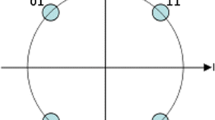Abstract
Unitary space-time code is ideally suited for rapid fading scenarios as it can operate well without channel state information (CSI), which is of vital significance for improving the effectivity and reliability of wireless communication systems. Pair-wise error probability (PEP) is an important factor for studying the reliability of a communication system. However, the existing scheme only gives the final result of PEP and the corresponding Chernoff upper bound (CUB) is obtained through magnification, which is not of universal significance for this kind of problems. In this paper, we employ the log-likelihood ratio of probability density functions of the received signals conditioned on the two possibly transmitted signals and by virtue of moment generating function we give the details in deriving the final precise residue expression for PEP and its CUB. At last, we verify the above results by simulations.
Similar content being viewed by others
References
Telatar I E. Capacity of multi-antenna Gaussian channels. Technical Report, AT&T Bell Labs, 1995
Foschini G J, Gans M J. On limits of wireless communication fading environment when using multiple antennas. Wirel Person Commun, 1998, 6: 311–335
Marzetta T L, Hochwald B M. Capacity of a mobile multiple-antenna communication link in Rayleigh flat fading. IEEE Trans Inf Theory, 1999, 45: 139–157
FRAMES Multiple access proposal for the UMTS radio interface-SMG2. Workshop on UMTS Radio Interface Technologies, 1996
Hochwald B M, Marzetta T L. Unitary space-time modulation for multiple-antenna communications in Rayleigh flat fading. IEEE Trans Inf Theory, 2000, 46: 543–564
Hughes B L. Differential space-time modulation. IEEE Trans Inf Theory, 2000, 46: 2567–2578
Hochwald B M, Sweldens W. Differential unitary space-time modulation. IEEE Trans Commun, 2000, 48: 2041–2052
Wei R Y, Wu Y L. Unitary space-time trellis codes. In: Proc IEEE PIMRC 2003, Beijing, China, 2003. 1017–1021
Hassibi B, Hochwald B M. Cayley differential unitary space-time codes. IEEE Trans Inf Theory, 2002, 48: 1485–1503
Jing Y, Hassibi B. Unitary space-time modulation via Cayley transform. IEEE Trans Signal Process, 2003, 51: 2891–2904
Oggier F, Hassibi B. Algebraic Cayley differential space-time codes. IEEE Trans Inf Theory, 2007, 53: 1911–1919
Foschini G J. Layered space-time architecture for wireless communication in a fading environment when using multiple antennas. Bell Labs Tech J, 1996, 1: 41–59
Tarokh V, Seshadri N, Calderbank A R. Space-time codes for high data rate wireless communication: performance criterion and code construction. IEEE Trans Inf Theory, 1998, 44: 744–765
Alamouti S M. A simple transmit diversity technique for wireless communications. IEEE J Select Areas Commun, 1998, 16: 1451–1458
Tarokh V, Jafarkhani H, Calderbank A R. Space-time block coding for wireless communication: performance results. IEEE J Select Areas Commun, 1999, 17: 451–460
Jafarkhani H, Tarokh V. Multiple transmit antenna differential detection from generalized orthogonal designs. IEEE Trans Inf Theory, 2001, 47: 2626–2631
Li J, Yang Y H. The impact of spatial fading correlation on unitary space-time code. J Shanghai Jiaotong Univ, 2006, 40: 377–381
Zheng L, Tse D N C. Communication on the Grassmann manifold: A geometric approach to the noncoherent multiple-antenna channel. IEEE Trans Inf Theory, 2002, 48: 359–383
Cheng J, Chen M, Cheng S X. Space-time coding technique in wireless communication. J Circuits Syst, 2002, 7: 66–95
Li Y, Xie X Z, Wang X M. The summary on space-time codes. J Electr Inf Tech, 2002, 24: 1973–1979
Proakis J. Digital Communications. 3rd ed. New York: McGraw-Hill, 1995
Trees V. Detection, Estimation, and Modulation Theory-Part I. New York: Wiley, 1968
Zhang X D. Matrix Analysis and Application. Beijing: Tsinghua University Press, 2004
Author information
Authors and Affiliations
Corresponding author
Rights and permissions
About this article
Cite this article
Zhang, D., Liu, J., Xu, H. et al. Pair-wise error probability and its Chernoff upper bound for unitary space-time code. Sci. China Inf. Sci. 53, 1613–1621 (2010). https://doi.org/10.1007/s11432-010-4020-y
Received:
Accepted:
Published:
Issue Date:
DOI: https://doi.org/10.1007/s11432-010-4020-y




